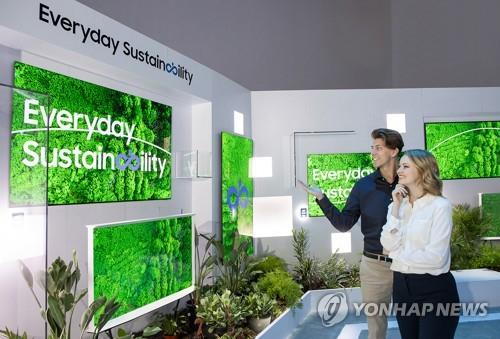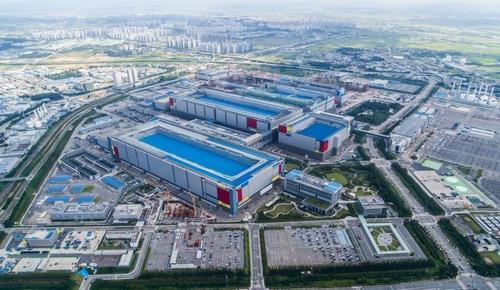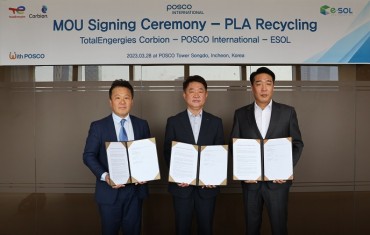
The file photo provided by Samsung Electronics Co. on Jan. 4, 2023, shows its exhibition booth for sustainability efforts during CES 2023 in Las Vegas. (Yonhap)
SEOUL, Sept. 13 (Korea Bizwire) — With the one year anniversary of Samsung Electronics Co.’s release of its mid- to long-term environmental management strategy nearing, the South Korean tech giant has said it was on the path toward achieving net zero companywide by 2050.
In September last year, Samsung unveiled the New Environmental Strategy, detailing its road map to achieve net zero at the Device eXperience (DX) division, covering its mobile and home appliances business, by 2030 and at the company level, including its chip Device Solutions (DS) division, by 2050.
And Samsung has made some progress on the sustainability front to keep its word, its recent report showed.
The company’s use of renewable energy rose 65 percent last year to reach 8,704 gigawatt hours, according to Samsung’s 2023 sustainability report in June.
The DX division reported the highest transition rate of 93 percent, while the rate stood at 23 percent at the DS division and at 31 percent companywide.
In 2020, Samsung completed its transition to 100 percent renewable energy in the United States, Europe and China. Last year, the company did so at all of DX division’s business sites in South Korea, and manufacturing sites in Vietnam, India and Brazil, according to the report.
Samsung, one of the world’s biggest manufacturers of electronic devices and semiconductors, also said it had reduced 10.16 million tons of carbon dioxide compared with business-as-usual, up 59 percent from the previous year.
Use of recycled and recyclable materials had increased, with 98,826 tons of plastic with recycled resin being used last year at a utilization rate of 14 percent and collecting 600,502 tons of electronic waste.
Samsung planned to expand the use of renewable resins in all its plastic products by 50 percent by 2030 and 100 percent by 2050.

The file photo provided by Samsung Electronics Co. on Aug. 30, 2023, shows the new BESPOKE AI Washer & Dryer Combo with Digital Inverter Heat Pump technology. (Yonhap)
Last year, Samsung joined the RE100, a global corporate initiative aimed at shifting to 100 percent renewable electricity. It vowed to increase the energy efficiency of its seven biggest-selling products, ranging from smartphones and washers to air conditioners, by 30 percent.
While admitting to difficulties in reaching its ambitious goal, largely because its high energy consumption to produce a vast array of products makes it harder to get alternative renewable energy sources, Samsung stressed the shift to eco-friendly production and management is “integral” to remain competitive and continue sustainable growth in a changing global business environment.

Samsung Electronics Co.’s semiconductor manufacturing campus in Pyeongtaek, 70 kilometers south of Seoul, is seen in this file photo provided by the company on Sept. 7, 2022. (Yonhap)
As semiconductor manufacturing requires a huge amount of water to clean silicon wafers and cool down equipment, Samsung also said it will try to freeze water consumption in its global chip lines to the 2021 level by 2030, despite active capacity expansion around the world. Samsung is the world’s largest memory chip maker and the second-largest contract chip manufacturer after Taiwan’s TSMC.
The total amount of reused water had gone up by 29 percent in 2022 from a year ago. Samsung said it maximized water reuse by improving its manufacturing processes and reuse systems, and by reusing low density waste water at the Pyeongtaek Campus, the world’s largest semiconductor facility, located some 70 kilometers south of Seoul.
In the report, Samsung said its eco-friendly efforts last year produced a total sustainability value of 116.88 trillion won (US$88.9 billion), including a financial value of 55.65 trillion won, which rose 39 percent from a year earlier.
This year, the total value is forecast to sharply decline “due to the global economic recession and industry stagnation,” the report said.
But Samsung said it will continue investing in environmental management activities, such as “semiconductor process gas reduction, e-waste collection and recycling, water resource preservation, and pollutant minimization.” Samsung has previously said it plans to invest over 7 trillion won by 2030 to reduce its carbon footprint and battle climate change.
(Yonhap)






